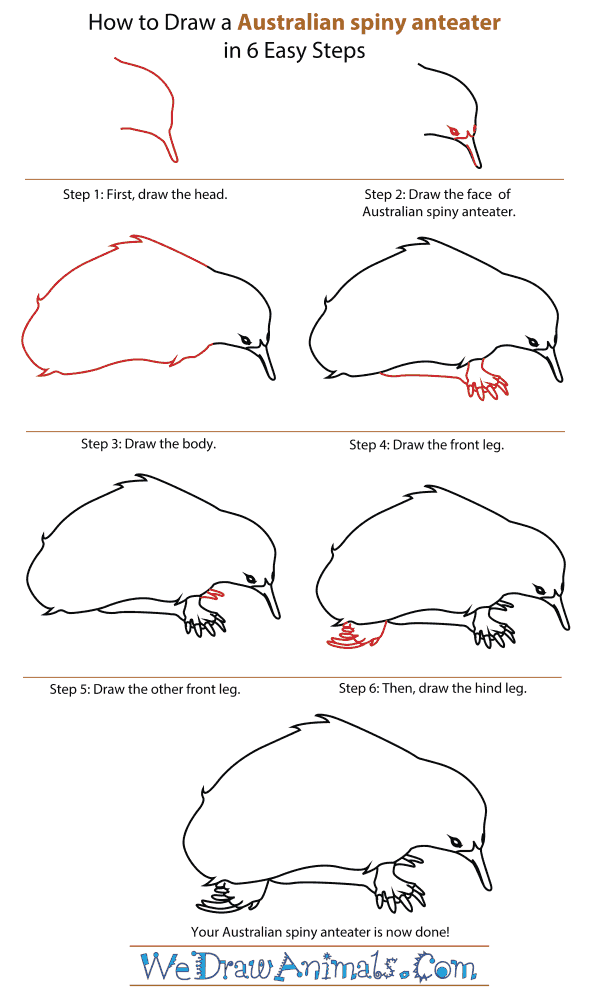In this quick tutorial you'll learn how to draw an Australian Spiny Anteater in 6 easy steps - great for kids and novice artists.
The images above represent how your finished drawing is going to look and the steps involved.
Below are the individual steps - you can click on each one for a High Resolution printable PDF version.
At the bottom you can read some interesting facts about the Australian Spiny Anteater.
Make sure you also check out any of the hundreds of drawing tutorials grouped by category.
How to Draw an Australian Spiny Anteater - Step-by-Step Tutorial
Step 1: The Australian Spiny Anteater is a mammal also known as an echidna. Most mammals give live birth to their young, but a spiny anteater lays eggs instead! The spiny anteater is only found in Australia and New Guinea. To draw one, start by making a backwards ‘C’ shape for the head. Add a long point snout. This long snout is what helps the anteater find its favorite food – ants!
Step 2: Add two eyes and small line across the snout. Add a small line for his mouth on the snout. Spiny anteaters are very shy.
Step 3: Draw the body – it will look like a sideways ‘U’ shape with jagged edges for the spines.
Step 4: Now draw one of the anteater’s front legs. His front legs are short and little, and end in five ‘fingers’ with long sharp claws at the end.
Step 5: Draw some extra claws behind the first ones to make the other front leg.
Step 6: Draw the back leg. The claws on his back leg are longer than those on his front. Now your spiny anteater is done! Did you know that baby spiny anteaters are called puggles? Like a kangaroo, their mothers keep them in a pouch until they are ready to venture out on their own.
Interesting Facts about Australian Spiny Anteaters
The Australian spiny anteater, simply called the spiny anteater, is native to Australia and New Guinea. They are called spiny because of the sharp spines, which make them look like hedgehogs or porcupines. They are one of only two monotremes in the world; the other is the platypus. Monotremes are the only mammals that lay eggs.
Did you know?
- They are also called echidna, named after the figure in Greek mythology known as the “Mother of all Monsters,” who was half-snake and half-woman.
- When attacked, they curl up in a ball and use their spines to scare off predators.
- They have long sticky tongues that they use to catch their food. They are insect-eaters (or insectivores). Their diet includes termites, ants, and earthworms.
- There are long-nosed and short-nosed Australian spiny anteaters. Both kinds use their snouts to dig through dirt to find their food.
Female Australian spiny anteaters lay one egg at a time in their pouch, which is located on their belly. The egg hatches after 10 days. Like kangaroos, the mothers carry and nurse their young (called puggles) in their pouch. The puggles stay there for almost two months, at which time they are big enough to leave.







